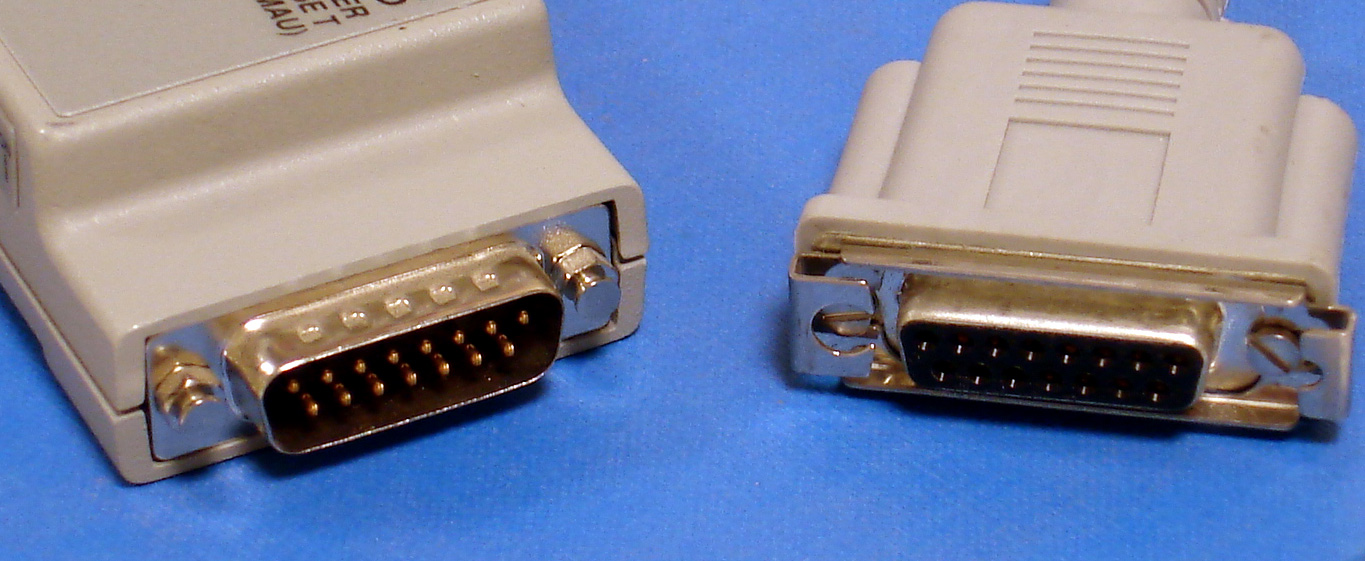Attachment Unit Interface on:
[Wikipedia]
[Google]
[Amazon]
 The Attachment Unit Interface (AUI) is a physical and logical interface defined in the original
The Attachment Unit Interface (AUI) is a physical and logical interface defined in the original
 An AUI connector is a DA-15 ( D-subminiature). It has a sliding clip in place of the thumbscrews normally found on a D-connector to hold two connectors together. This clip permits the MAU and MAC to be directly attached to one another even when their size and shape would preclude the use of thumbscrews. This clip is however frequently found to be awkward and/or unreliable.
An AUI connector is a DA-15 ( D-subminiature). It has a sliding clip in place of the thumbscrews normally found on a D-connector to hold two connectors together. This clip permits the MAU and MAC to be directly attached to one another even when their size and shape would preclude the use of thumbscrews. This clip is however frequently found to be awkward and/or unreliable.
 The Attachment Unit Interface (AUI) is a physical and logical interface defined in the original
The Attachment Unit Interface (AUI) is a physical and logical interface defined in the original IEEE 802.3
IEEE 802.3 is a working group and a collection standards defining the physical layer and data link layer's media access control (MAC) of wired Ethernet. The standards are produced by the working group of Institute of Electrical and Electronics Eng ...
standard for 10BASE5 Ethernet and the previous DIX standard. The physical interface consists of a 15-pin D-subminiature connection that provides a path between an Ethernet
Ethernet () is a family of wired computer networking technologies commonly used in local area networks (LAN), metropolitan area networks (MAN) and wide area networks (WAN). It was commercially introduced in 1980 and first standardized in ...
node's physical signaling and the Medium Attachment Unit (MAU), sometimes also known as a transceiver
In radio communication, a transceiver is an electronic device which is a combination of a radio ''trans''mitter and a re''ceiver'', hence the name. It can both transmit and receive radio waves using an antenna, for communication purposes. The ...
. An AUI cable may be up to long, although frequently the cable is omitted altogether and the MAU and medium access controller MAC are directly attached to one another. On Ethernet implementations without separate MAU and MAC, the AUI is omitted.
AUI connectors became rare beginning in the early 1990s when computers and hubs began to incorporate the MAU, particularly as the 10BASE-T standard became more common and use of 10BASE5 (thicknet) and 10BASE2
10BASE2 (also known as cheapernet, thin Ethernet, thinnet, and thinwire) is a variant of Ethernet that uses thin coaxial cable terminated with BNC connectors to build a local area network.
During the mid to late 1980s this was the dominan ...
(thinnet) declined. The electrical AUI connection was still present inside the equipment. With the introduction of Fast Ethernet
In computer networking, Fast Ethernet physical layers carry traffic at the nominal rate of 100 Mbit/s. The prior Ethernet speed was 10 Mbit/s. Of the Fast Ethernet physical layers, 100BASE-TX is by far the most common.
Fast Ethern ...
the AUI became obsolete, and was replaced by the Media Independent Interface (MII). Gigabit Ethernet
In computer networking, Gigabit Ethernet (GbE or 1 GigE) is the term applied to transmitting Ethernet frames at a rate of a gigabit per second. The most popular variant, 1000BASE-T, is defined by the IEEE 802.3ab standard. It came into use i ...
and 10 Gigabit Ethernet
10 Gigabit Ethernet (10GE, 10GbE, or 10 GigE) is a group of computer networking technologies for transmitting Ethernet frames at a rate of 10 gigabits per second. It was first defined by the IEEE 802.3ae-2002 standard. Unlike previous Et ...
have respectively the GMII and XGMII interfaces.
A modified form using a smaller connector called the AAUI was introduced on Apple Macintosh
The Mac (known as Macintosh until 1999) is a family of personal computers designed and marketed by Apple Inc. Macs are known for their ease of use and minimalist designs, and are popular among students, creative professionals, and software ...
computers in 1991, and its use discontinued in 1998.
Connector and signals
 An AUI connector is a DA-15 ( D-subminiature). It has a sliding clip in place of the thumbscrews normally found on a D-connector to hold two connectors together. This clip permits the MAU and MAC to be directly attached to one another even when their size and shape would preclude the use of thumbscrews. This clip is however frequently found to be awkward and/or unreliable.
An AUI connector is a DA-15 ( D-subminiature). It has a sliding clip in place of the thumbscrews normally found on a D-connector to hold two connectors together. This clip permits the MAU and MAC to be directly attached to one another even when their size and shape would preclude the use of thumbscrews. This clip is however frequently found to be awkward and/or unreliable.
See also
* XAUI * Apple Attachment Unit InterfaceReferences
{{Ethernet Ethernet Computer connectors